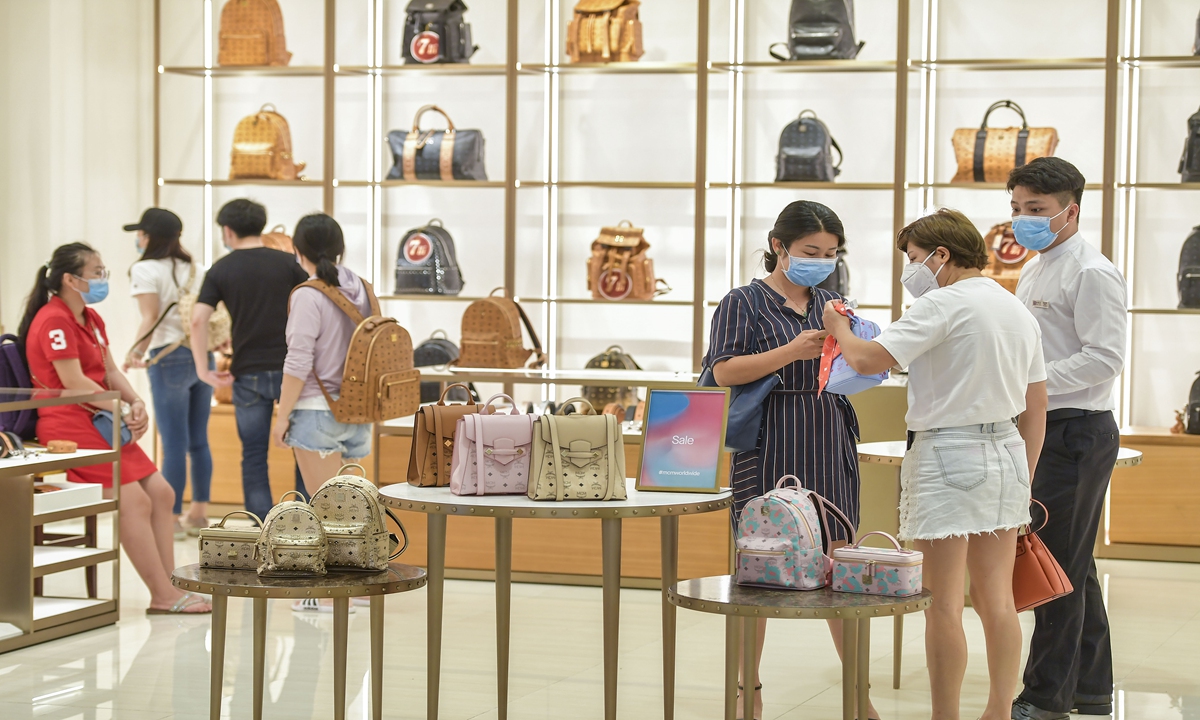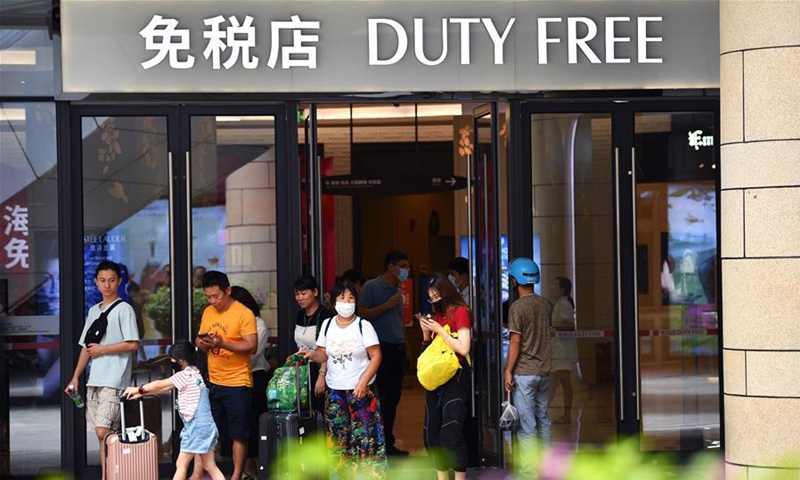Duty-free sales in Hainan top $1 billion in two months, boosting confidence to build global tourism, shopping center
By Zhang Dan Source: Global Times Published: 2020/9/16 18:50:56
Duty-free sales on the island top $1 billion over 2 months

Tourists shop in a bag store at Haikou Riyue Plaza duty-free shop in South China's Hainan Province on May 2. Photo: cnsphoto
A 26-year-old tourist from Beijing surnamed Hu was slack-jawed this August when she visited the Haitang Bay Duty-Free Shopping Center in Sanya, South China's Hainan Province, which is striving to develop itself into a free trade port."All of the shops have queues. The shopping frenzy is like Black Friday in Western countries. You must scramble for what you want!" Hu told the Global Times.
According to official data, sales from offshore duty-free shops in Hainan surpassed 7 billion yuan ($1.03 billion) from July 1 to early September. More than 830,000 consumers contributed to this, Sanya publicity authorities said on Tuesday.
COVID-19 has kept Chinese tourists within the country as international travel restrictions have not been eased across the globe. This gave domestic duty-free shops an opportunity to attract consumers and unleash the potential consumer spending - a sector which was keenly scrutinized, as some have said that sluggish domestic consumption means it will take some time for the world's second-largest economy to recover fully.
However, positive signals have appeared. China's retail sales returned to positive growth in August for the first time this year, rising 0.5 percent year-on-year to about 3.36 trillion yuan.
Tourism analysts estimate the duty-free shopping in Hainan will become a highlight during the upcoming National Day holiday in early October which will give Chinese an eight-day break. Along with an anticipated tourism boom, China's duty-free shopping market is likely to further expand.
Rising sales
From fragrances to cosmetics, and luxury watches to bags, Hu said every corner of the shopping center was crowded.
"You'd better have someone accompany you when shopping in the duty-free centers in Hainan: one to queue up to pay, and another to choose the purchase items in order to save time," she told the Global Times.
"I never thought there would have been so many buyers during the coronavirus epidemic control." Failing to squeeze in most of the shops, Hu only bought a bottle of face cream.
The price difference on expensive products is evident. Take Apple's iPhone 11 Pro Max 256GB as an example. It sells for 8,625 yuan in a duty-free shop in Hainan, some 2,274 yuan lower than the price on Apple's website, according to media reports.
With an expanded offshore duty-free shopping policy announced on July 1 that raised personal annual duty-free shopping quota from 30,000 yuan to 100,000 yuan, there has been an immediate uptick in sales.
Liu Cigui, Party chief of Hainan, said in a television interview recently that the average daily sales of offshore duty-free shopping topped 130 million yuan, with the highest daily record of 170 million yuan.
It is not easy to achieve such results when the number of tourists to Hainan in the first half year dropped by nearly a half compared with last year, according to Chen Xi, head of the Hainan Provincial Department of Commerce.
"The introduction of the new offshore duty-free policy has played a significant role in promoting tourism and consumption in tandem with improving our overall tourism environment and consumption climate," Chen said during the same television interview.
Statistics provided by China's biggest online travel agency Trip.com Group showed the number of trips to Hainan in August grew more than 60 percent month-on-month, and Sanya remained one of the most popular destinations for Chinese after the coronavirus pandemic.
"Sanya is known for its high-end leisure vacation trips, hence it has attracted travelers who had planned to travel to overseas destinations before the pandemic. Thanks to the catalytic effect of favorable polices to build the free trade port, including duty-free tax policies, there will be a boom in tourism in Hainan during the upcoming National Day holiday," Peng Liang, an analyst at Trip.com Group's vacation business unit, told the Global Times, adding that the volume of individual travel bookings to Sanya accounts for a large amount of bookings on the platform now.

Tourists visit a duty-free store in Haikou, capital of south China's Hainan Province, Aug. 18, 2020. China's island province of Hainan has recorded 2.49 billion yuan (about 360 million US dollars) in duty-free shopping by tourists in July. During the period, about 384,000 tourists visited the island, up 54.1 percent year on year. (Xinhua/Guo Cheng)
Innovation urged
Among the popular duty-free products sold in Hainan, cosmetics contributed almost half of the total revenue in July and August, according to local customs data. Watch sales hit 670 million yuan in summer, accounting for 12 percent of the total revenue while jewelry ranked third.
Cosmetics are daily necessities. Some Chinese agents make a living on buying cosmetics from Japan, South Korea or the Hong Kong Special Administrative Region on behalf of others. But such behavior is strictly banned in Hainan.
According to Chinese authorities, whoever is found to be reselling, buying for others or smuggling duty-free products for profit will be forbidden from buying offshore duty-free goods in Hainan for three years. Moreover, the offense will be recorded in China's social credit system.
In July, 39 people buying products for others to earn a profit were arrested in Hainan.
However, Yang Jinsong, director of the International Institute at the China Tourism Academy, is concerned that the duty-free stimulus in Hainan may weaken after the coronavirus ends.
"Compared with duty-free products in Hainan, South Korean products are mostly made in the country and cannot be bought elsewhere. It is so far difficult to find particular products that you could only purchase in Hainan," Yang told the Global Times, urging the island to make innovations on the duty-free products.
He suggested home-made high-tech products should be promoted in the free trade port, such as Huawei smartphones and DJI drones, in order to make the port famous for competitive Made-in-China products and attract more foreign buyers.
"The innovations of duty-free products and competitive home-made products matter not only to China's duty-free industry development, but also the overall environment of 'Made-in-China' and 'Created in China'," Yang stressed.
According to the estimates by the New Times Securities, the duty-free market scale in Hainan would surpass 60 billion yuan by 2022.
Newspaper headline: Hainan on the rise
Posted in: MARKETS